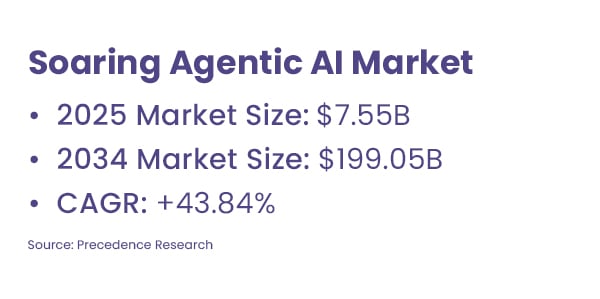Smarter Document Scanning with Machine Learning
Explore how machine learning transforms document scanning and data management, improving accuracy, automation, and insight across industries.
Discover how Agentic AI transforms document scanning into intelligent, automated workflows that improve accuracy and efficiency.
For decades, document scanning has served as the bridge between physical information and digital workflows. While OCR, automation, and scanning technology have advanced, the core challenge remains: turning static documents into actionable, intelligent data.
Agentic AI addresses this challenge by not just processing information – but understanding it, reasoning through it, and taking autonomous action. By combining AI-driven decision-making with human-guided objectives, organizations can move beyond simple digitization to fully intelligent workflows.
This evolution aligns with the rapid growth of Intelligent Document Processing (IDP), a cornerstone of modern document scanning. According to Fortune Business Insights, the IDP market is projected to expand from $10.57B in 2025 to $66.68B by 2032, reflecting a CAGR of 30.1%. This trend is fueled by the enterprise demand for faster, more accurate data extraction and validation.
At Scan-Optics, where decades of experience in IDP meet cutting-edge innovation, Agentic AI empowers organizations to unlock efficiency, accuracy, and actionable insight at every stage of the information lifecycle.

Agentic AI is a significant evolution beyond traditional automation or even machine learning. Rather than executing a narrow set of instructions, agentic systems can reason, plan, and adapt to changing inputs. As technology leader NVIDIA explains, agentic AI uses a cognitive loop of reasoning and learning to solve complex problems, often breaking down a large task into smaller, logical steps.
Think of them as digital collaborators. They assess a task, determine the best next step, and refine their approach over time, much like a seasoned employee who learns on the job.
Where traditional AI might classify a scanned invoice, an Agentic AI system can understand the invoice’s context, check for anomalies, cross-verify amounts, and even trigger corrective actions or follow-up workflows – all without manual intervention.
This “agentic” quality is autonomy with accountability. It is what allows organizations to scale efficiency and intelligence simultaneously. This shift is so profound that consulting firm McKinsey & Company suggests it is giving rise to the “agentic organization,” a new operating model built around AI agents that reshape workflows and decision-making. And nowhere is that more powerful than in the realm of document scanning and information management, where precision and speed directly affect business outcomes.
For years, automation has been about doing repetitive tasks faster. Optical Character Recognition (OCR) captured text, Robotic Process Automation (RPA) routed it, and Intelligent Document Processing (IDP) extracted and classified it.
But these systems were still rule-based. When something unexpected appeared, such as a missing field, a handwritten note, or a new form layout, they often stopped cold. That’s where human review had to fill the gaps.
Agentic AI changes that. It doesn’t just execute; it evaluates and reasons. The key difference is that while traditional intelligent automation follows predefined pathways, agentic automation can make independent decisions to achieve a goal. These systems use cognitive models and multi-agent coordination to determine intent, context, and priority, enabling them to make informed decisions in real time.
In document scanning workflows, this means:
The result? Fewer manual touchpoints, faster cycle times, and exponentially higher accuracy.
Every organization relies on documents: contracts, applications, invoices, medical forms, and compliance records. They are the connective tissue of operations, but they can also create data bottlenecks.
Even in highly digitized industries, scanning and processing paper or image-based files is still a challenge. Layouts vary, handwriting is unpredictable, and contextual decisions, such as determining whether a signature is valid or identifying which system a document belongs to, often require human judgment.
Agentic AI changes this dynamic in several critical ways:
Agentic AI systems learn from each scan. If a healthcare intake form appears with a new field or a different layout, the system recognizes and adapts automatically. This makes the scanning process more resilient and less dependent on static templates.
Where traditional OCR stops at text recognition, Agentic AI interprets meaning. It can distinguish a patient record from an insurance claim, or identify which data belongs to which department—all by analyzing structure, phrasing, and intent.
Rather than waiting for human correction, Agentic AI agents flag and resolve inconsistencies on their own, checking data against known patterns or external databases. That self-correcting loop dramatically improves accuracy.
Agentic systems don’t just follow workflows; they refine them. Over time, they learn from user feedback and outcomes, improving the way information is categorized, validated, and shared.
At Scan-Optics, technology always serves people, not the other way around. Agentic AI enhances this principle by freeing teams from repetitive review tasks so they can focus on strategic, human-driven decision-making.

Agentic AI is transforming how organizations handle documents, turning labor-intensive scanning and processing tasks into streamlined, intelligent workflows. By combining advanced reasoning with automation, these systems not only digitize information but also interpret, validate, and route it with minimal human intervention. Across healthcare, financial services, higher education, and the public sector, agentic AI is proving its value by improving efficiency, accuracy, and compliance.
In healthcare, speed and precision can directly impact patient outcomes. Agentic AI enables real-time validation of scanned medical documents, from lab reports to billing claims. It ensures data consistency across systems while maintaining compliance with privacy and accessibility standards. According to Grand View Research, the adoption of agentic AI in healthcare is rapidly growing, driven by the need to automate administrative workflows and improve data management from sources like OCR.
Imagine a hospital scanning hundreds of patient forms daily. Agentic AI identifies duplicates, verifies insurance information, and routes data directly to electronic health record (EHR) systems, reducing administrative backlog and error rates.
Banks and financial institutions handle enormous volumes of scanned documents, including loan applications, disclosures, and identity verification records. Agentic AI analyzes these in context, automatically categorizing and flagging anomalies that could indicate fraud or compliance gaps. Thomson Reuters notes that agentic workflows are becoming essential in professional services for streamlining document-heavy tasks and ensuring regulatory adherence.
The technology also supports audit readiness by maintaining an intelligent trail of reasoning: each decision made by an AI agent is explainable and traceable, satisfying emerging regulatory expectations around AI transparency.
Universities and colleges manage vast archives of transcripts, applications, and forms. Agentic AI can digitize and organize these documents into accessible repositories, using natural-language reasoning to classify and connect data points.
For institutions focused on digital equity, this approach also improves accessibility, ensuring that scanned documents are properly tagged and optimized for screen readers and inclusive design.
Government agencies often face the steepest challenges in digital transformation due to decades of paper accumulation. Agentic AI helps bridge the gap between analog records and digital access by managing the scanning, indexing, and validation process end to end.
By autonomously interpreting document types, like permits, claims, and licenses, it accelerates modernization while ensuring accountability and security for sensitive data.
Agentic AI doesn’t replace IDP; it elevates it. Traditional IDP solutions extract information. Agentic AI-enhanced IDP understands and acts on that information. It brings dynamic reasoning to existing workflows, orchestrating multi-step processes that previously required multiple systems or multiple people. This evolution is transforming the IDP landscape, with industry platforms leveraging agentic AI to accelerate document handling and enable on-the-fly decision-making.
For example:
That’s not just automation; it’s orchestration. It transforms static document processing into an intelligent, interconnected network of tasks, where each action informs the next.-1.jpg?width=528&height=263&name=SCO-Newsletter-Stat-Callout2%20(1)-1.jpg)
Agentic AI is already driving measurable value across industries. In their analysis of top IDP solutions for 2025, qBotica emphasizes that smarter, faster workflows powered by AI are delivering tangible ROI.
Organizations adopting agentic workflows are seeing 40–60% faster document turnaround times, along with:
These outcomes align directly with Scan-Optics’ mission: making information more intelligent, accessible, and actionable.
By embedding agentic AI into document scanning solutions, organizations reimagine how work flows.
At the core of Scan-Optics’ approach is a belief that digital transformation should be human-centered. Technology serves best when it empowers people, not replaces them.
Agentic AI embodies that philosophy by taking on the cognitive load of routine processing. It handles the analyzing, comparing, and validating that once required manual effort. This allows people to focus on what they do best: interpreting nuance, exercising judgment, and driving strategy.
As these systems continue to evolve, human oversight remains essential. Just as a manager trains and guides a new team member, business leaders train and monitor their AI agents to ensure alignment with organizational goals and ethics.
That symbiosis between human direction and agentic autonomy is where true transformation happens.
Adopting Agentic AI doesn’t require starting from scratch. Many organizations can layer it onto existing document management or IDP frameworks.
Here’s how forward-thinking teams are getting started:
Scan-Optics partners with organizations to guide them through each stage – from planning to implementation – ensuring technology adoption remains aligned with business strategy and compliance standards.
At Scan-Optics, we offer more than leading-edge document scanning and automation technology. Our team delivers a comprehensive blend of deep expertise, strategic guidance, and a partnership approach designed to make Agentic AI work for your business.
Our team collaborates closely with clients to understand their unique workflows, identify the most impactful automation opportunities, and implement scalable, secure, and future-proof solutions that evolve alongside organizational goals.
Whether your company is exploring Intelligent Document Processing (IDP) for the first time or seeking to scale advanced automation across departments, Scan-Optics provides a clear, actionable roadmap. Together, we’ll transform traditional paper-heavy bottlenecks into streamlined, intelligent operations that enhance efficiency, accuracy, and accessibility.
Discover how automation and intelligent processing are reshaping the modern workplace:
Are you ready to move beyond traditional automation and experience the next level of intelligent document processing? Contact Scan-Optics today and discover how Scan-Optics can help you turn every document into a driver of insight, agility, and long-term success.
Explore how machine learning transforms document scanning and data management, improving accuracy, automation, and insight across industries.
Discover how hyperautomation, powered by Scan-Optics, can transform document management & boost efficiency. Learn about AI, RPA, and real-time...
Discover how Intelligent Document Processing (IDP) enhances efficiency, reduces costs, and improves accuracy. Learn more with Scan-Optics.